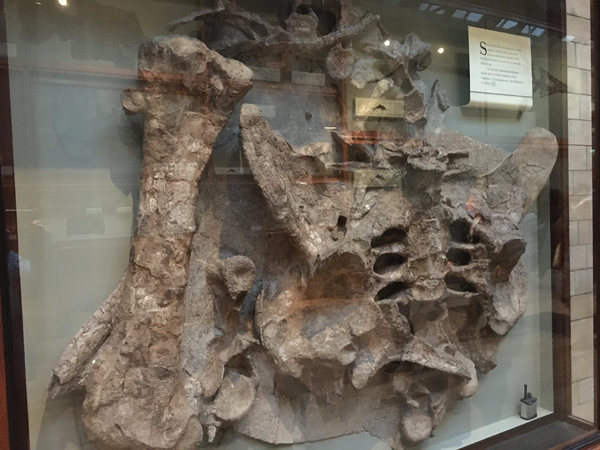The First Stegosaur Dacentrurus armatus
Situated amongst specimens of marine reptiles in the Mary Anning gallery at the London Natural History Museum is a remarkable fossil specimen. Behind its glass case the viewer can make out a block of bones containing various vertebrae, a massive right femur (thigh bone), ribs and a near complete pelvis. At approximately two metres across this is an impressive fossil specimen. It is the holotype material for Dacentrurus armatus (NHMUK OR46013), the first large collection of dinosaur bones associated with a member of the Stegosauridae to be scientifically described and studied.
The Main Bone Block (D. armatus) at the Natural History Museum (London)

Picture credit: Everything Dinosaur
The Everything Dinosaur website: Everything Dinosaur.
The Fossils of Dacentrurus
The fossils come from a clay quarry close to the town of Swindon in the county of Wiltshire. Richard Owen (later Sir Richard Owen), who was to play a pivotal role in the foundation of the institute that we now know as the London Natural History Museum, studied the fossils and erected the name Omosaurus armatus in 1875. The genus name, Omosaurus had already been used to describe a North American phytosaur (O. perplexus) in 1856. Therefore, the original genus name for this armoured dinosaur was invalidated. In 1902 the eminent American zoologist, Frederick Augustus Lucas erected Dacentrurus.
CollectA have produced a Dacentrurus figure. This model is in their Deluxe model range.
To view the CollectA Deluxe range: CollectA Deluxe Prehistoric Life.
With the recently published paper describing a new specimen of Miragaia longicollum, a “Rosetta Stone” moment in vertebrate palaeontology permitting scientists to better understand the Dacentrurinae subfamily of the Stegosauridae, it is fitting that whilst in London an Everything Dinosaur team member took the opportunity to take a photograph of the main Dacentrurus block. The beautiful fossils are notoriously difficult to photograph, but still, they continue to play a role in helping to decipher Late Jurassic stegosaurs.
On Display in the Wrong Gallery?
One mystery still remains, why is this important dinosaur fossil on display in the marine reptiles gallery? Perhaps, one day, these hugely significant fossils we will placed in the dinosaur gallery, where visitors could be given the opportunity to learn more about the world’s first extensively studied armoured dinosaur specimen.
To read our recent article on the M. longicollum paper: Turning a Stegosaur Fossil into the Rosetta Stone.






It’s gigantic. I saw ti’s when I visited and its much lather than he Stegosaurus bones.